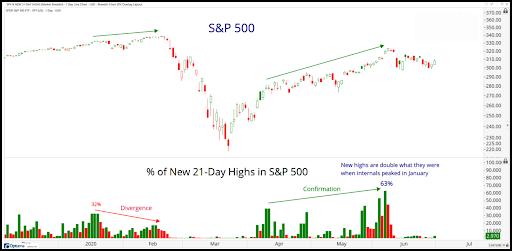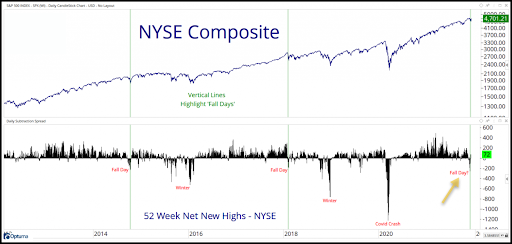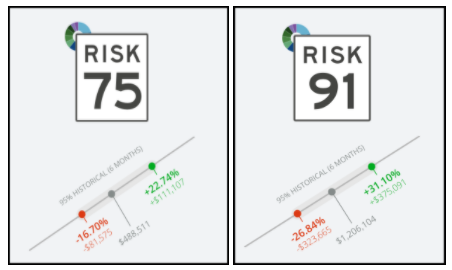Related Blogs
December 12, 2021 | Michael Reilly
Investors have been holding their breath as the S&P 500, the DJIA, the NASDAQ, and even the Russell 2000 Small-Cap Index has moved from one extreme to the other over the last two weeks.
When markets sell-off and quickly rebound, investors often find themselves in one of two camps.
The first group is jumping back in with both feet…
Screaming “What an opportunity! Let’s buy!”
While the other group is much more reserved… waiting for the proverbial “other shoe” to drop.
This group in particular is discovering that maybe they can’t handle as much risk as they previously thought…
After the market tanked in 2020, investors panicked when the S&P 500 shed more than 30% in a matter of weeks. It was painful…
Fearing the worst, many investors sold what they could and hoped for the best.
Nobody knew what the first pandemic in over 100 years could bring.
But what most investors couldn’t see was market breadth improving after the March low, leading to an eventual spike in breadth…
Meaning more and more stocks were breaking new highs, indicating that we were in the early innings of a new bull cycle and a great buying opportunity.
You can see it here – the S&P 500 along with a breadth measurement, looking at the percentage of S&P 500 stocks making new highs over the previous 21 days.

The fact that more and more stocks were rising was a strong bullish signal, giving hesitant investors another shot at profits.
The market in 2021 however, has been characterized by corrective price action and generally weak market internals. Nothing like 2020.
Although what we’ve seen in 2021 is historically normal during year two of a bull market, it’s still frustrating… and sometimes scary.
We’ve seen sideways, choppy price behavior since February.
And from a breadth perspective, markets in 2021 haven’t come close to the highs we saw from breadth indicators of 2020.
That’s not necessarily the worst thing because market internals (breadth) often peak early on in a new cycle.
But what bullish investors don’t want to see is a meaningful deterioration in breadth.
And here’s where things get a little dicey right now…
During this most recent sell-off, markets have experienced some of the highest readings of new lows since the COVID crash.
So, we may have exactly what we don’t want to see!
Fewer and fewer stocks moving higher, with more and more moving lower.
Was that it for the bulls? Was that the last gasp?
Are the bears getting ready to take control, sending markets substantially lower?
We don’t know yet. I wish it were that easy, but it’s not black and white.
From a breadth perspective, we want to know if what we just experienced was what we’ll refer to as “fall day” – a day when we see a big spike in selling.
These “fall days” are associated with markets that have run out of steam, where the spike in new lows in breadth is often followed by a sell-off in the index soon after.
Take a look at this chart of the NYSE where you can see the new highs for the New York Stock Exchange looking back over the last few cycles.

The recent increase in new lows (yellow arrow) represents a clear change from what we’ve seen from stocks compared with what stocks have done over the previous 18 months. That’s important information.
This is by far the most significant amount of new lows since the first quarter of 2020.
It should also be noted that the current reading looks a lot like the “fall days” from 2014 and 2018.
In other words, it’s time to sit up and take notice.
Unfortunately, it’s only with hindsight can we know for sure if what we just witnessed was the beginning of the end for this bull run…
So now is the time for investors to remain vigilant, and on the lookout for further weakness.
One thing we do know for sure is that market tops and bottoms aren’t an event, they’re more of a process. And that’s good for you as an investor…
Because this process provides investors like you the opportunity to prepare for either occurrence.
All the technical data is great, it can paint a picture of markets under the surface, where it really happens…
But all that data is useless if you haven’t already considered what is arguably the most important aspect of your investment success – proper risk management.
Over my more than 30 years of experience, I have learned that most people think they can handle a lot more risk than they can.
And the only way most people figure it out is when the damage is already done.
If you don’t understand your “risk number” – the amount of volatility or loss you can comfortably withstand within your account…
AND you haven’t structured your portfolio to behave in a manner consistent with your propensity for risk…
You’ve already lost. It’s just a matter of time.
That’s why we utilize a risk assessment process at Rowe Wealth that’s designed to help investors consider real dollar and cents terms.
Because nobody feels percentages, right?
If I were to ask you, “How would you feel if your account fell by 15% next week?”…
It feels very different than if I asked you, “How would you feel if your account lost $175,000?”
See what I mean?
Our aim is to not just help you find your true tolerance for risk…
But to also look at your risk tolerance compared to the risk you’re actually taking in your portfolio.
You’d be surprised how often those two numbers don’t match!

The point of the exercise is for you to understand, well in advance of a market reversal, what you could expect to happen in your portfolio.
And given the uncertainty in today’s markets, wouldn’t you like to know what to expect?
If you’d like to talk a little more about your risk, and how we can help you know what to expect no matter how the market is turning, give us a call. We’re opening our doors to new investors who have portfolios valued over $500,000. If you’d like to schedule a free 1-hour consultation to review your portfolio and determine your risk score, click here.
Let’s talk soon,

Tags

Get Our FREE Guide
How to Find the Best Advisor for You
Learn how to choose an advisor that has your best interests in mind. You'll also be subscribed to ADAPT, Avalon’s free newsletter with updates on our strongest performing investment models and market insights from a responsible money management perspective.

